Editor’s Note: this article first appeared in the Spring 2010 issue ofProtocol, the journal of PLASA (formerly known as ESTA), the lead international association for those who supply technologies and services to the event, entertainment and installation industries. Minor revisions have been made due to the publication of the 2011 edition of theNational Electrical Code®.
For some time, the proper control of emergency lighting circuits has been a topic of debate for manufacturers, systems integrators, and specifying electrical engineers. Much of the debate has centered on the proper application of the many codes and standards that apply to emergency lighting. These include:
ANSI/NFPA 70, National Electrical Code (NEC),Article 700, Emergency Systems
NEC Article 701, Legally Required Standby Systems
NEC Article 702, Optional Standby Systems
NFPA 110, Standard for Emergency and Standby Power Systems
NFPA 101, Life Safety Code
Underwriters Laboratories (UL) Standard 924, Emergency Lighting and Power Equipment
Underwriters Laboratories (UL) Standard 1008,Transfer Switch Equipment.UL1008 covers transfer switches that are rated for use in emergency systems and for other applications. Unless noted otherwise in this article, we are examining UL1008 transfer switches for emergency systems only.
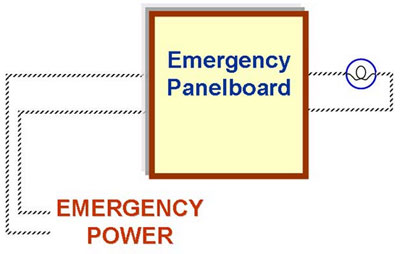
Figure 1. Case 1 – Normal
(See sidebar at the end of the article for more information about theNECand these UL standards).
Each of these standards focuses on a specific area of emergency or standby lighting and power, or describes a specific piece of equipment somewhere in the path of the emergency or standby lighting or power circuit. However, it is not always easy to answer all application questions by searching these standards since they often point at each other, creating a circular answer, or in many cases, a lack of an answer. For the entertainment and architectural lighting industries, one of the burning questions has been: “Where is it appropriate to use a UL1008 emergency transfer switch, and where can a simpler UL924 load control relay be used to energize an emergency lighting circuit?”
Due to the relative cost and complexity of UL1008 emergency transfer switches, for many years the industry kept asking whether such a switch was really necessary for dimmer branch circuits, especially since in all likelihood there was another UL1008 switch somewhere in the building, transferring a main feeder between normal and emergency power. The answer to this question is not a simple one, and it requires a review of the full spectrum of options in the emergency lighting toolbox. Each of the following cases has a place in the design of emergency lighting systems. It should be noted that these case drawings have been simplified to illustrate functionality, and do not contain every detail of the circuits they describe.

Figure 2. Case 1 – Emergency
Case 1. Emergency-only lights on an emergency-only circuit
The Case 1 arrangement is probably the simplest possible way to energize emergency lighting fixtures. A number of emergency-only fixtures are dedicated to providing the minimum illumination levels required by the NFPA 101, Life Safety Code, or local building codes. The lighting fixtures are fed from a dedicated emergency-only breaker panel fed directly from the emergency power source, which may be a generator or uninterruptable power supply (UPS). When the source comes on line, the lights are energized without any switching or transfer equipment. The one disadvantage to this arrangement is that the emergency fixtures will be dark when normal power is present. This may be a visually unacceptable situation for the architect or lighting designer.
Case 2. Designated emergency lights with self-contained power source
Case 2 is familiar to anyone who has used self-contained battery pack emergency lights, sometimes called “unit equipment.” These units are listed under UL924 and contain a power source (usually a battery), a charger, and a load control relay. The unit is connected to normal power, which provides charging current for the battery. When normal power fails, the load control relay energizes the load. When normal power returns, the load is extinguished. For many years, battery packs were the norm for emergency lighting. They are inexpensive, but battery maintenance and the “car-headlight” look of the unit can be problematic. Case 2 can also use similar unit equipment that utilizes a recessed emergency luminaire which is more esthetically pleasing than a car-headlight battery pack.
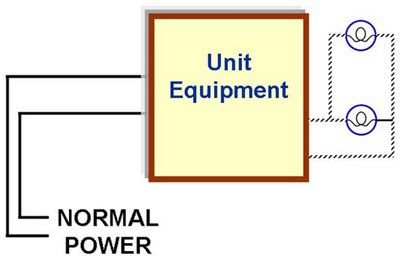
Figure 3. Case 2 – Normal
Case 3. Normal/emergency lights on switches or wallbox dimmers
Case 3 introduces the concept of using the same fixture for both normal and emergency use. Normal/emergency lights are fed via a normal/emergency breaker panel and a wall switch, wallbox dimmer or other wallbox-mounted control device. When normal power fails, an upstream UL1008 emergency transfer switch automatically transfers the feeder of the breaker panel to an emergency power source. At the same time, a UL924 load control relay senses the loss of normal power upstream from the transfer switch and bypasses the switch or dimmer, forcing the load on, no matter what the position of the switch or dimmer. Note that the UL924 load control relay is not performing a transfer function, but merely a bypass or shunt function. Thus it is only required to switch the hot leg of the branch circuit. Some normal-power control devices, however, do not allow shunting (e.g., an autotransformer), and thus require a double-throw load control relay to disconnect the load from the normal control device before applying power to the load. While the double-throw construction of the relay can be misleading, this break-before-make bypass is not a transfer function. Case 3 always relies on the upstream UL 1008 emergency transfer switch for the transfer function.
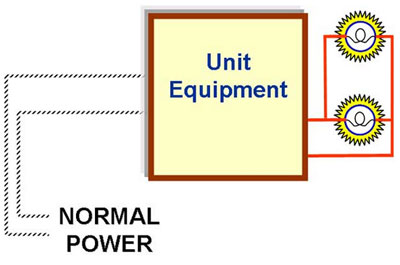
Figure 4. Case 2 – Emergency
Case 4. Normal/emergency lights on a UL 924 listed dimmer rack or relay cabinet
Case 4 extends the use of the same fixtures for both normal and emergency use, because the fixtures are fed by a dimmer rack or relay cabinet that is listed for emergency use under UL924, as well as the more conventional UL508/UL891 listing. The dimmer rack contains a load control relay, or an electronic bypass method. When normal power fails, the entire feeder to the dimmer rack is transferred to an emergency source by an upstream UL1008 emergency transfer switch. Controls sensing normal feeder failure upstream from the transfer switch cause the internal load control relays or electronic bypass devices to energize selected circuits by bypassing dimmers, and forcing loads on, no matter what the state of the dimmer control system. Only those loads needed to reach minimum emergency illumination are energized, as allowed by NEC 700.23 (a new section in 2008). Note that the behavior of other circuits in the dimmer rack needs to be known when using this approach. If non-emergency circuits continue to respond to the control system when the rack is in emergency mode, then the size of the emergency source needs to accommodate these loads as well. A better solution is to use a UL 924 dimmer rack with load-shedding capability. This will insure that non-emergency dimmers are forced into an off condition at the same time that emergency dimmers are forced into an on condition when the rack is in emergency bypass mode. Note that NEC 700.23 requires all circuits leaving the dimmer cabinet to comply with Article 700 as emergency circuits, i.e., wired separately from all normal-only circuits, whether or not they are energized to get to the required illumination.
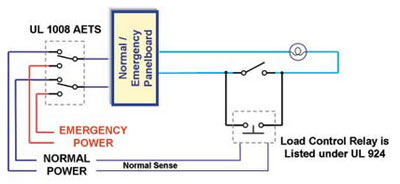
Figure 5. Case 3 – Normal
Case 4A. Normal/emergency lights on a dimmer system with an external UL 924 load control relay
Recently, external stand-alone UL924 load control relays have become available for bypassing circuits in a dimmer rack that does not have a native UL924 listing. It is this Case 4A that generates the most confusion, because, at first glance, the function performed by the relay looks like a transfer (which actually must be performed by a UL1008 emergency transfer switch), not a bypass. However, that is not the case, and here’s why: In this case, the load control relay switches the load between the dimmer output and an external circuit breaker connected to the same phase and power source as the dimmer. The single feeder to the dimmer rack is transferred by an upstream UL1008 emergency transfer switch, making one feeder operate as both the normal and emergency source for the dimmer rack. Therefore, the UL924 load control relay is providing a bypass rather than transfer function. As in Case 4, the state of the non-emergency circuits in the dimmer rack must be forced to off when in emergency mode. If not, the emergency power source must accommodate the full load connected to the rack, not just the emergency bypassed circuits. In practical terms, this gets tricky, because it requires interaction between the emergency system and the dimmer control system. A better solution may be found in Case 5.
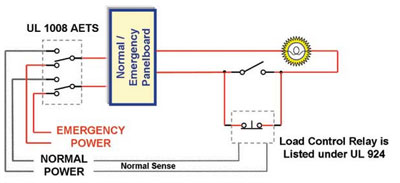
Figure 6. Case 3 – Emergency
Case 5. Normal/emergency lights on a UL1008 branch circuit automatic (emergency) transfer switch
Case 5 describes a design widely adopted by the industry. The dimmer rack is fed by normal power only, and shuts down during a normal power failure. For each normal/emergency load, both the neutral and the hot conductor are transferred to a separate emergency source via a UL1008 branch circuit (emergency) automatic transfer switch (BATS). The switch is designed to insure that it can withstand the available fault current during transfer, and can never interconnect the normal and emergency power sources. In addition, the switch must work safely when the normal and emergency sources are on different phases and not synchronized. Case 5 is useful when a dimmer rack is fed by a very large feeder, but only a small portion of the branch circuits will be used for emergency. The use of the BATS allows those circuits to be selectively transferred to the emergency source without worrying about sizing the emergency source to deal with the full capacity of the dimmer rack feeder. The downside to Case 5 is the size, cost, and complexity of the UL1008 switch.
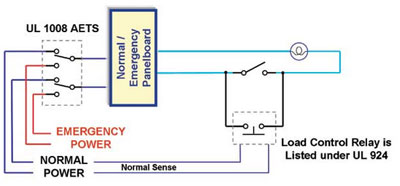
Figure 7. Case 4 – Normal
What does UL say about emergency circuits, UL924 and UL1008?
Recently, a number of manufacturers of UL924 load control relays have produced products with installation manuals that suggested the relays could be used for Case 5 applications, where the load was transferred rather than bypassed. In the Spring 2005 issue of The Code Authority (UL’s newsletter on code issues), the article “Focus on Emergency Lighting Equipment” appears on page 3. In the second paragraph, that article states, “An important issue to recognize is that an LCR does not switch the load between the normal and emergency supplies. Load switching of this type should only be performed by a[n emergency] transfer switch listed in accordance with UL1008, Standard for Safety for Transfer Switch Equipment. An LCR has only one power input source, and that is connected to the emergency power supply.”
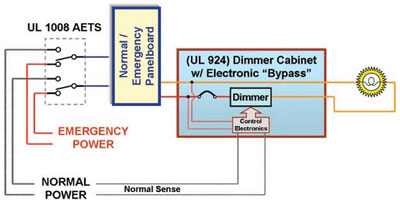
Figure 8. Case 4 – Emergency
In addition the UL White Book clearly differentiates Automatic Transfer Switches for Use in Emergency Systems (product category WPWR), Automatic Transfer Switches for Use in Optional Standby Systems (WPXT), and Automatic Load Control Relays (product category FTBR).
It is also important to note that NEC 700.5(C) states two clear requirements: “Automatic transfer switches shall be electrically operated and mechanically held. Automatic transfer switches, rated 600 VAC and below, shall be listed for emergency system use” (authors’ emphasis). Be aware that some products marketed as automatic transfer switches and listed under UL 1008 are for optional standby systems (NECArticle 702), not emergency use. These same devices may be also listed under UL924 as an emergency bypass device. See sidebar for further discussion on the difference between an emergency circuit, a legally required standby circuit, and an optional standby circuit.
New Sections in NEC-2011
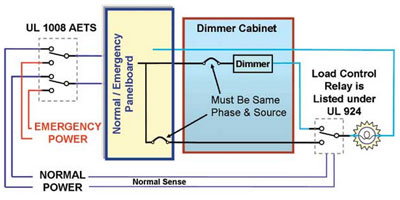
Figure 9. Case 4A – Normal
New language was added to the 2011 edition of the NEC.
“700.2 Definitions
“Relay, Automatic Load Control.A device used to energize switched or normally-off lighting equipment from an emergency supply in the event of loss of the normal supply.
“Informational Note: For requirements covering automatic load control relays, see ANSI/UL924, Emergency Lighting and Power Equipment.”
“700.24 Automatic Load Control Relay.If an emergency lighting load is automatically energized upon loss of the normal supply, a listed automatic load control relay shall be permitted to energize the load. The load control relay shall not be used as transfer equipment.”

Figure 10. Case 4A – Emergency
How do I choose the right emergency control method for my application?
For each project, the emergency system designer must review the field conditions and examine the pros and cons of each approach to arrive at the most economical but safe system. The first step is usually to determine whether a true Article 700 emergency system is required or whether something less, like an Article 702 optional standby system, is acceptable. If the project includes specifying the primary automatic emergency transfer switch at the service entrance and generator, then UL1008 equipment is required and NFPA110 will most likely apply. If the project requires a branch circuit emergency transfer switch (BATS), the expense of a UL1008 emergency transfer switch is still required but the auxiliary equipment specified in NFPA110, such as generator start-up controls, is not. This auxiliary equipment will be provided by the primary UL1008 transfer switch at the service entrance. If the project is to turn on an emergency circuit controlled by a wallbox dimmer, a UL1008 emergency transfer contactor is a bit expensive, while a UL924 bypass relay is sufficient.
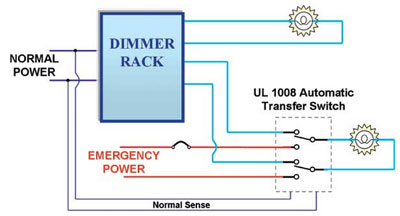
Figure11. Case 5 – Normal
After selecting the proper approach to the project, equipment must be selected that functions together as a system to meet the safety objectives of the project. A UL1008 automatic emergency transfer switch is designed for the conditions found on feeder circuits. In addition to being safe, it must have sensing circuitry to automatically transfer on failure of the normal source to assure the transfer happens automatically and reliably.
On the other hand, UL924 equipment covers a broader range of devices and applications, is subject to less rigorous testing and may be subject to misapplication unless the system designer is careful. Unit equipment, exit luminaires and recessed emergency luminaires will probably have all the elements required to make a functional emergency system. Other stand-alone UL924 components may not. For instance, Listed UL924 metering devices are available to sense normal feeder failure, but they will not be of much use if not mated with a suitable power switching device. There are listed UL924 power switching devices that, if not connected to correctly sense the upstream normal feeder, will turn the emergency illumination on when the branch circuit loses normal power but will turn off again when the generator takes over. How each piece of equipment functions must be researched in order to make the design work as a system. What doesn’t work is to haphazardly choose UL1008 listed equipment or UL924 listed equipment and assume you have successfully completed the project.
Conclusion

Figure 12. Case 5 – Emergency
When transferring a load between a normal and emergency power source, either in a feeder or branch-circuit application, a listed UL1008 emergency transfer switch must be used.
A dimming system with a dual listing under UL924 and UL508/UL891 may be used to energize emergency lights.
An external UL924 load control relay may be used to bypass a switch or dimmer to energize emergency lights, but may never be used to transfer emergency lights between a normal and emergency power source.










Find Us on Socials